Mark Sisson's Blog, page 247
October 3, 2015
Southwest Brisket with Pickled Jalapeños
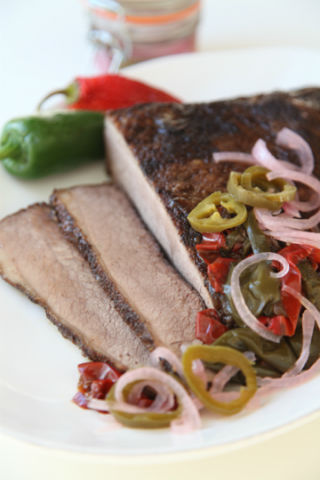 Brisket is comfort food, there’s no doubt about it. It’s nothing fancy, just
Brisket is comfort food, there’s no doubt about it. It’s nothing fancy, just
a big ‘ol piece of meat slow-cooked until tender, but man, is it good. In this recipe, traditional brisket is given Southwest flair with spices, peppers and pickled jalapenos. You can even add cilantro, if you like.
This recipe is loaded with peppers, both sweet and spicy. The bell peppers slow cook along with the meat, and the jalapeños are quick-pickled with vinegar and used as a garnish. Peppers are there for Southwest flavor, but also because they have vitamin C and B and carotene, and the capsaicin in the spicy ones can potentially be an effective anti-inflammatory.
This is a plan-ahead type of recipe, one you might want to start on the weekend with the intent of feasting early in the week. Mainly because time is brisket’s best friend. Time to soak up the seasoning, time to cook, and time to lie around before being reheated and eaten.
Servings: 8
Time in the Kitchen:
Plan ahead! Brisket tends to taste better and be most tender if it’s seasoned the night before it’s cooked, and then cooked a day before it’s eaten. On the day you plan to eat the brisket, simply re-heat it in the oven.
Day 1: Buy and season the brisket. Let it rest overnight in the refrigerator.
Day 2: Cook the brisket and make the pickled jalapeños. (1 hour of hands-on cooking time, plus 3 hours in the oven)
Day 3: Re-heat the brisket (35 minutes)
Ingredients:
Brisket:
1 (4 – pound) brisket (1.8 kg)
1 tablespoon kosher salt (15 ml)
1 teaspoon black pepper (5 ml)
1 tablespoon chili powder (15 ml)
1 teaspoon cumin (5 ml)
2 tablespoons extra-virgin olive oil (30 ml)
2 white or yellow onions, thinly sliced
4 garlic cloves, thinly sliced
1 cup beef stock or red wine (240 ml)
1 red bell pepper, sliced
2 green bell peppers, sliced
1 bay leaf
Pickled Jalapeños:
3 jalapeños, sliced into ¼-inch rounds
1 small red onion, very thinly sliced
4 garlic cloves, thinly sliced
½ cup unseasoned rice vinegar (120 ml0
½ cup water (120 ml)
1 tablespoon kosher salt (15 ml)
1 teaspoon sugar (5 ml)
1 bay leaf
Instructions:
Mix together the salt, black pepper, chili powder and cumin. Rub the spices all over the brisket. Cover and refrigerate overnight (or at the very least, 4 hours.) Let meat stand at room temperature 30 minutes before cooking.
The day before, or at least 4 hours before, pickle the jalapeños. In a small saucepan, heat the vinegar, water, salt, sugar and bay leaf until it’s simmering, and the salt and sugar dissolve.
Add the jalapeños, onion and garlic. Turn off the heat and cover. Let stand 20 minutes.
Pour into a clean jar. Let cool, then cover and refrigerate.
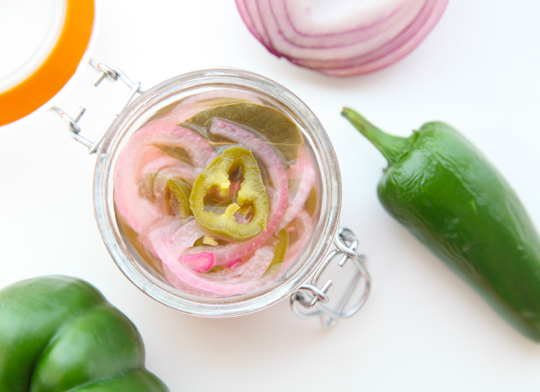
When you’re ready to cook the brisket, heat oven to 325 °F/163 °C.
Heat a large Dutch oven on the stove. Add the olive oil. When the oil is hot, add brisket and sear 4 to 5 minutes per side until each side is nicely browned. Remove meat from the Dutch oven. (If the brisket is too large to fit into any of your pots, it can be cut in half or thirds)
Add onions and garlic to the pot (adding more oil if necessary) and reduce the heat to medium. Cook onions until golden brown and soft, about 10 minutes.
Pour in the wine and scrape up any browned bits from the bottom of the pot. Bring the liquid to a simmer for 5 minutes. Add the bell peppers and bay leaf. Add the meat back to the pot. Cover and transfer to the oven.
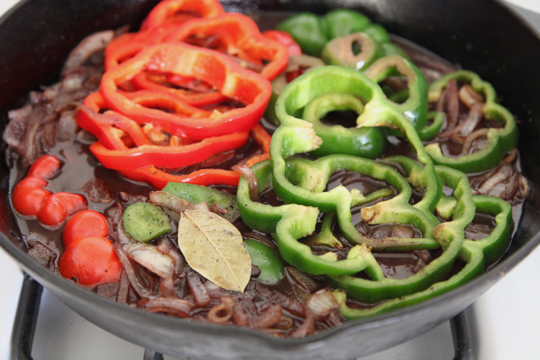
Cook, turning every 30 minutes, until meat is very soft and fork tender, about 3 hours. For the last 30 minutes, remove the lid so the liquid reduces some. Keep an eye on the meat; if it gets too brown, put the lid back on.
Let the brisket cool, then cover and refrigerate overnight. The next day, scrape off any excess fat, if desired. Reheat the brisket in the same pot, covered, for 30 to 40 minutes in a 350 °F/177 °C oven.
Slice the meat against the grain and serve with the pickled jalapeños on top.
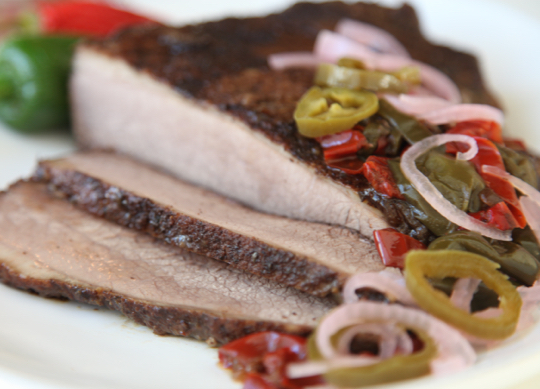
Not Sure What to Eat? Get the Primal Blueprint Meal Plan for Shopping Lists and Recipes Delivered Directly to Your Inbox Each Week. Now Available as an App!



October 2, 2015
Over 100 Pounds Lost Is Just Part of the Story
It’s Friday, everyone! And that means another Primal Blueprint Real Life Story from a Mark’s Daily Apple reader. If you have your own success story and would like to share it with me and the Mark’s Daily Apple community please contact me here. I’ll continue to publish these each Friday as long as they keep coming in. Thank you for reading!
 When I was 13, I started having a lot of sick days. Initially, I was having migraines from time to time. Then one day they seemed to be happening on a very regular basis. I started seeing different doctors, and they couldn’t figure out why I was having them. By this time I started vomiting, sometimes multiple times a day, but it was every single day. I also started having trouble sleeping. When 8th grade rolled around, I was seeing doctors all over the place, having weekly tests done for a million different things, but still nothing showed. I was on a lot of different medications that no child should ever have to take, and the only thing that happened was extreme weight gain, basically. My every day life was hell. On top of being so sick, and having no answers, I was tormented daily at school which didn’t help. Before I knew it I was also on anti-depressants, anti-anxiety medication, and had begun therapy.
When I was 13, I started having a lot of sick days. Initially, I was having migraines from time to time. Then one day they seemed to be happening on a very regular basis. I started seeing different doctors, and they couldn’t figure out why I was having them. By this time I started vomiting, sometimes multiple times a day, but it was every single day. I also started having trouble sleeping. When 8th grade rolled around, I was seeing doctors all over the place, having weekly tests done for a million different things, but still nothing showed. I was on a lot of different medications that no child should ever have to take, and the only thing that happened was extreme weight gain, basically. My every day life was hell. On top of being so sick, and having no answers, I was tormented daily at school which didn’t help. Before I knew it I was also on anti-depressants, anti-anxiety medication, and had begun therapy.
After two and a half years of constant testing, going to doctors all over the Midwest, continually being sick and getting no relief, we had a diagnosis: Lyme Disease. My blood tests were off the chart high. I began seeing a specialist that was eight hours away from home. During this time (and through the majority of high school), I had to be home-schooled, and I hated it. I was on nearly a dozen medications from extreme doses of antibiotics, to pain killers (Morphine, Vicodin…), migraine medication, sleeping pills, anti-depressants, anti-anxiety pills and the same anti nausea medications they give to chemo patients.
By this point I was 17 and getting weekly injections of the strongest antibiotic you can get. My nurses had me call them when I was on my way so they could warm the serum and change the needle to a smaller one because they couldn’t stand the thought of sticking me with the needle that came with it…yes, it was that big. It literally took a couple of minutes for them to push all of it into me. At the end of each injection, I was left with a rather large welt and bruise that would last until the following week when we would switch hips. The injections lasted for more than a year. I never got better. I think in time I simply became used to feeling like absolute hell day in and day out. This was my life. The only good things I had were my family, my friends and my faith. All I could do was trust that if God brought me to all of this, eventually HE would get me out of it. That is all that held me together, because believe me, I didn’t want to live. I wasn’t living. I was a zombie.
In time I got off of most of the medications because they no longer helped me anyway. From time to time over the next several years, new symptoms would show – bringing a new round of doctors, tests and sometimes medication (all while being uninsured mind you). More often than not, I tried to ignore my health problems because they were all I had known for so long.
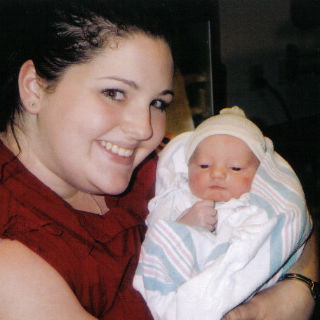 By the end of April of 2009, at the age of 23, I had moved to Florida in search of finding myself again. Shortly after I moved down there, my mom was diagnosed with breast cancer. I remember thinking to myself, “Hey life, it’s been a while since you’ve turned upside down, so why not?!” I was devastated and so scared.
By the end of April of 2009, at the age of 23, I had moved to Florida in search of finding myself again. Shortly after I moved down there, my mom was diagnosed with breast cancer. I remember thinking to myself, “Hey life, it’s been a while since you’ve turned upside down, so why not?!” I was devastated and so scared.
In time I found out that I never should have been put on a medication I had been on for a decade, so that was thrown out. Insert a new onset of health problems. Here I was 24, and now on top of my normal health problems, I was scared out of my mind that I was going to have cancer someday because the odds are SO high that I will. I starting having excruciating migraines again, I couldn’t sleep, and was now dealing with heart arrhythmia. New tests, new doctor, new meds, same ol’ song and dance.
By the time I was 26, I was living in Washington, D.C. and by all accounts should have been loving my life. The one thing I had been able to count on for thirteen years health-wise was that I could deal with (and on most days tolerate) certain levels of wanting to throw up all day (and thank God I no longer actually did every day), migraines, and bouts of insomnia.
In April of 2012, I sprained both ankles at the same time. Seemingly once I was fully recovered from that, something else started. By that September I would have rather been dead than feel the pain I was in every day. I had multiple emergency room trips, and the pain was chalked up to pinched nerves. I did everything suggested and nothing helped. I was throwing up pretty much daily again from the pain, and pain killers weren’t helping. I couldn’t sleep. I couldn’t do anything it seemed. I’m sure my ex was ready to be done with me and I felt like a burden to him. I became really depressed…again.
During this time, my mom was diagnosed with Fibromyalgia. Her doctor said you can be genetically predisposed to it and after telling him all of the ongoing problems I was having, he seemed to think it was very likely I could have it as well. I started seeing a doctor again after how bad the pain had gotten. I became obsessed with researching it. Because I had the Lyme’s diagnosis, we just chalked ALL problems up to being related to that. In reality though, Fibro made much more sense. During this time I began having such horrific joint and muscle pain that I cried throughout the day, and eventually cried myself to sleep every night. I would wake up in the middle of the night, practically screaming in pain. I wasn’t working and it was truly hell…again.
Christmas 2012 I got a juicer and I started researching natural Fibromyalgia treatments. I began reading The Primal Blueprint (and a few other books) a few months into juicing and was astonished. Everything made absolute sense. By going Primal, I had cut out virtually all dairy, all grains, all legumes, and all processed foods. I juice (though you don’t have to in order to be Primal, but I do because I love the energy that comes from the extra doses of fruits and veggies) and eat incredible tasting foods. Within the first two months of these changes, I had gone without a single prescription pain killer for the first time in literally 14 YEARS. I had a mere three migraines in those two months, and they paled in comparison to what I used to experience with them. I began sleeping well every night for the first time in 14 years. A bad night consisted of maybe 15-30 minutes of numbness or tingling sensations going up and down my body, but even that had become rare.
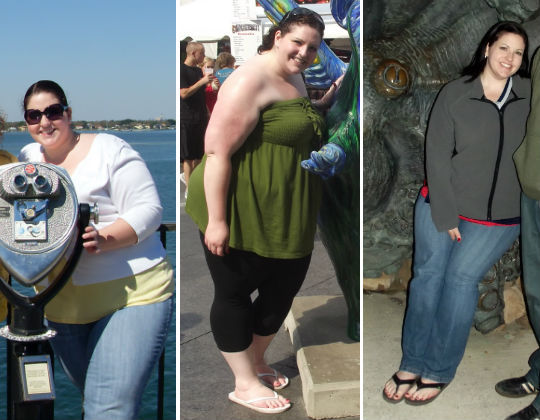
By May of 2013, I was down 104 pounds from my highest weight. I did my first Susan G. Komen Race for the Cure (5K, but still) and felt great. I traveled a lot that summer. I stopped blogging, hit a huge plateau and then God started shaking up my life…again.
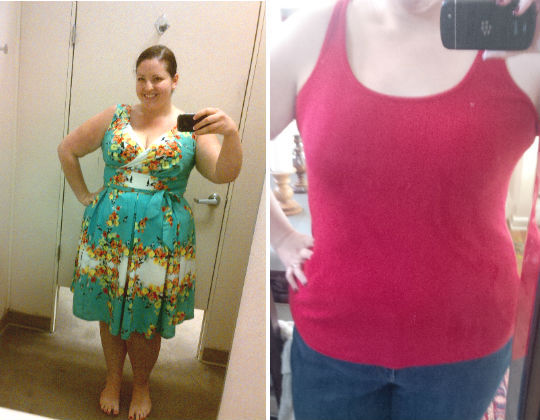
October of 2014 brought changes that I never thought would happen. My ex and I moved out of our apartment and into separate places, I stopped being pseudo step-mom to the child I loved as my own. I fell late that month and tore multiple ligaments in my foot and stopped working out for months because of it. My depression came back tenfold and I stopped caring. I stopped caring about making sure I was living the life that I knew made me feel better. When you are THAT depressed (though you don’t care and it’s all you can do to get up), you put on a happy face, go to work and not fall apart until you get home. In time, we finally broke up and I made the decision to leave DC and head back to my roots. I needed my people.
In May of 2014, I moved to St. Louis, which is two hours from my hometown and has been a second home to me for most of my life. By the middle of June I had spent more time with my family than I had in the three or four years prior. My heart needed that. Towards the end of that month, a very old friend that I grew up with was taken from this Earthly world far too soon. His death made me do a lot of soul searching. Through the rest of the summer, I realized just how much of myself I had willingly given up and/or had taken from me and decided that was no loner happening. I made the decision to embrace all of the good things that I had in my life. I had a pretty brutal fibro flare that lasted for a couple of months. By Labor Day I had gained back roughly 30 pounds. The funk that I had been in finally was gone.
 I started really getting back into the gym, bike riding, small reps of lifting and taking core muscle classes. I got back into juicing in the mornings to give me the instant boost I need and eat as Primal as possible the rest of the day. I’ve more than lost the 30 pounds I had gained back. I am at 130 (which makes for about sixty pounds since Labor Day 2014) pounds gone now. I still have another 80 or so to go but I feel SO good. The only medication I take now is Claritin. I don’t know if I’ll ever be able to go off of it, but to go from a dozen medications to ONE is amazing. I live life now. I embrace it. I own it. I know I have quite a ways to go still, but I know how far I’ve come. I have a blog about my experiences with juicing, Primal and obtaining a general sense of wellness in my life. It’s been read in 38 countries now, which is mind blowing to me. It’s therapeutic for me, but honestly, I feel like it’s my duty to let others know that they can absolutely change their stories. Just because your life has been a certain way for however long does not mean that is how it should be or how it has to be.
I started really getting back into the gym, bike riding, small reps of lifting and taking core muscle classes. I got back into juicing in the mornings to give me the instant boost I need and eat as Primal as possible the rest of the day. I’ve more than lost the 30 pounds I had gained back. I am at 130 (which makes for about sixty pounds since Labor Day 2014) pounds gone now. I still have another 80 or so to go but I feel SO good. The only medication I take now is Claritin. I don’t know if I’ll ever be able to go off of it, but to go from a dozen medications to ONE is amazing. I live life now. I embrace it. I own it. I know I have quite a ways to go still, but I know how far I’ve come. I have a blog about my experiences with juicing, Primal and obtaining a general sense of wellness in my life. It’s been read in 38 countries now, which is mind blowing to me. It’s therapeutic for me, but honestly, I feel like it’s my duty to let others know that they can absolutely change their stories. Just because your life has been a certain way for however long does not mean that is how it should be or how it has to be.
What’s different for me now is that my journey isn’t just about weight loss. The journey I’m on is one that I will be on for the rest of my life. It’s a journey of physical, emotional, mental and spiritual wellness. It’s a journey of helping to prevent some of the rather unfortunate genes I have inherited. It’s a journey about truly living life instead of just getting through it.
Tressie




October 1, 2015
Foodborne Illness Wrap-Up: The Role of Your Health and Your Food’s Health
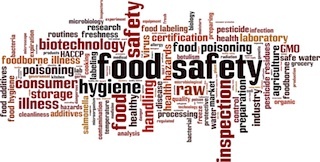 One of the things I love about doing this blog is the continual incentive to examine different angles of issues, dig up varying resources around questions and discern ways our smallest choices establish our broader health. Much of what I discuss here involves avoiding chronic diseases – the lifestyle conditions that plague our modern Korg society. And given the stats, it makes sense to give these the majority of attention. Still, other concerns exist that grab people’s curiosity. Whatever the presiding health headlines are in a given week/month, I find I’ll get messages about these topics from readers. And such was the case with the foodborne illness theme.
One of the things I love about doing this blog is the continual incentive to examine different angles of issues, dig up varying resources around questions and discern ways our smallest choices establish our broader health. Much of what I discuss here involves avoiding chronic diseases – the lifestyle conditions that plague our modern Korg society. And given the stats, it makes sense to give these the majority of attention. Still, other concerns exist that grab people’s curiosity. Whatever the presiding health headlines are in a given week/month, I find I’ll get messages about these topics from readers. And such was the case with the foodborne illness theme.
Truth be told, it’s not something I personally think much about. As I mentioned in Monday’s Dear Mark, I eat raw oysters without a second thought. I’ve written in the past about rare meats, and I believe in eating dirt when homegrown or reputably sourced, organically grown veggies offer it. That said, I’m a robust person with good gut health. I eat foods that have been raised as naturally as possible because I consider it worth the benefit to my well-being and because I have the means and opportunity to do so.
Why Take a Balanced Approach to Foodborne Illness?
I recognize that not everyone lives the way I do. Even within the MDA community, there’s a whole lot of diversity. I’m not just preaching to the fully converted here, although I learn a great deal from those who have taken the Blueprint and chosen to run with it in their everyday lives.
Some in the community here are still living with poor or mediocre health—perhaps with compromised immune systems—as they contemplate or work their way toward a version of Primal living that can serve their needs. Others are significantly older than I am and might be ambivalent about the risks of some choices. Still others are looking to feed a family with little ones. Some might be well on their way to embracing many of the Primal principles but haven’t yet found or are unable to take advantage of the better food sources we share here. Others might have to make frequent Primal compromises because of job travel or other availability issues. I can speak generally about optimum Primal choices, but I can’t assume that all readers can or will or perhaps in every given instance should follow them.
This was my concern when I decided to take up the foodborne illness issue. I know some readers were a little taken aback by and even took issue with seeing some conventional sounding messaging, particularly in the last installment about food storage and cooking. I get it. I’ll admit it even felt strange to go down that road—one of the reasons I think I’ve perhaps chosen to not take up the issue in the past.
As I mentioned in my first post a couple weeks ago, addressing the “threat” of foodborne illness will never be about eradicating risk. That’s a naive proposition, and the attempt would likely lead people to make poorer food choices (and industry to further degrade food during processing).
And yet there’s enough health risk (at least in certain pathogens like E. Coli and salmonella) to take the issue seriously. The answer should ideally be the application of sound, reasonable strategies to minimize original contamination, pathogen spread and illness development.
And the risk varies. Some people would likely pay a bigger price from certain types of food poisoning based on their current health status. Others run a bigger risk because they eat food more likely to carry pathogens. That’s where more heavy duty recommendations come in like those in last week’s kitchen strategies post. The fact is, conventional food obliges certain conventional precautions. And, frankly, some people just prefer the extra preventative measures for reasons that are none of my business. When it comes to to these ideas, I think it’s the old adage, take what works for you and leave the rest.
And yet… What about the fully Primal take? What do I personally do and might suggest as optional considerations for those who have no added risk factors and who live a healthy, Primal existence?
Let me add my final two cents on the subject with these last two critical dimensions of foodborne illness risk and prevention. As always, I’m not offering medical advice to my readers—but lifestyle options for their personal deliberation. These last two themes are, of course, core Primal territory—and elements of the issue you don’t read much about in most discussions of food safety.
I referenced these last week as I explained what to look for in Part 3, but maybe I should’ve added “Wait for it…” because, for the reasons I described above, I felt beholden on this particular issue to lay out the more extensive cautionary explanations first—then a Primal perspective. Sure enough, however, for those who were wondering, here it is….
Food Sources: The Logic of Risk
We hear more these days about foodborne illnesses because mainstream media has gone the route of fear-mongering. Scary sells, I guess. But there’s also the fact that much of our food supply is mass produced on factory farms (often not even in this country, let alone our personal localities) and then distributed across the nation if not globe. What’s that saying about one bad apple ruins the bunch?
Add to this concern the fact that processing facilities and distribution centers can harbor the pathogens of that one bad apple (or cucumber or tomato or box of sprouts or side of beef) and pass it on to whatever else goes through the machinery and storage units. Here’s where industry guidelines regarding sanitation can come in handy, but we’re dealing with a hardly foolproof system here, not to mention a grossly overburdened regulatory set of agencies (FDA and USDA).
While I’m glad those industry guidelines are in place given the mass production and corner-cutting system we have in place, I personally have more faith in knowing my food sources—the more detail, the better. Let me share a story—not my own but a good example of what I mean.
As the bees and I were first talking about this subject a while back, one of the staff members shared something from her pre-California days. Back in her Midwest days, she regularly purchased a farm share each year from a regional uncertified organic farm that had one of the best reputations for its produce and member service. You could visit the farm, and talk with the farmers both onsite and at a couple large farmers’ market venues in her metro area. Their website offered extensive explanations of the farmland, the varying crops, their growing techniques and natural means of pest control. Every week members got a letter explaining the produce that had been harvested and how it had been grown and stored or shipped.
One week, however, emails and letters went out as did those weekly letters explaining that the pepper fields had been subject to flooding. While workers had endeavored to harvest the field’s crop before the waters washed into the field, they were unsuccessful in picking everything before the field was slightly covered in the rain and overflow.
Some of the crop was disposed of, the communications explained. What the workers deemed salvageable was soaked in solutions of hydrogen peroxide and scrubbed out of concern that contaminated runoff from a nearby livestock field (not part of an organic farm) might have had contact with the field. Members were apprised of all the details, of the washing solution and other strategies used, advised of conventional precautions they could take on their own if they wished to use the peppers in that week’s shipment (bagged and contained separate from the rest of the week’s share).
The Worker Bee whose story this is followed the suggested precautions that week (even though most weeks she only lightly rinsed the farm produce) and made a delicious salsa from these veggies of concern. In the end, no one got sick from those peppers or anything else from the farm, but (not surprising to me) their donations rose considerably that quarter, and they had more people sign up for the following year’s memberships than ever.
If this all sounds generous (it is) or even excessive, consider what you don’t know about your food—the fields it’s grown in, what surrounding elements might influence those fields, who harvests it and what sanitation amenities they’re offered. Would you know if fields were flooded and subject to possible contamination?
In terms of meats and poultry, would you know how the animals were fed, confined, medically treated and otherwise raised? When we’re talking about animals, we’re automatically talking about proximity to feces. Do you want your cattle sources regularly standing in several inches of excrement from thousands of their bovine compatriots in a CAFO lot, or would you feel better if they were allowed to graze freely over a large expanse? What does logic say about disease spread here?
This is why I’m such a fan of buying from small sources and knowing your farmer – whether it be from farmers’ markets, local meat share farms or CSAs or even from reputable online farm distributors. Even certain larger farming cooperatives offer more transparency than you’ll ever get from land run by an absentee Big Ag company. Big corporations make their profit from bulk sales. Small farms or even forward-thinking cooperatives stay in business on solid reputation, customer experience and a quality product worth the extra money. Not to mention illnesses would likely be easier to trace (and faster to nip in the bud) in a smaller group of farm share members than a cross-national cohort. Personally, I don’t mind paying for that kind of accountability and transparency.
The Presence and Potency of Foodborne Pathogens: What the Research Says
As for the research, some sources suggest the picture is mixed. In terms of produce, much was made of a study back in 2004 that found organic produce (9.7%) was more likely to test positive for E. coli and salmonella than conventional produce (1.6%). However, when researchers broke down the results further, certified organic farms (which are required to follow USDA regulations that are designed to eliminate pathogen presence in natural fertilizer) came up as 4.3%, and researchers labeled the difference between certified organic and conventional as statistically insignificant.
In terms of meat, even the USDA admits relevant research is “scarce.” (PDF) While most existing research suggests there is no appreciable difference in actual incidence of bacterial pathogens in organic versus conventional meat, infections from conventional food sources tend to be more antibiotic resistant.
So, these might be the most “negative” studies and viewpoints, the most damning of organic and pastured food sources—except they’re not really. Is there, however, other research and evidence that organic or naturally (pastured) raised food is, indeed, safer than conventional? You bet.
Some research, indeed, suggests otherwise. When young cattle that had tested positive for E. coli 0157.H7, the type most responsible for human E. coli illness and death, they were separated into two groups—one raised indoors and one raised on pasture. Six months later those who were pastured showed no sign of E. coli, while all calves that had been kept in the barn still tested positive.
Likewise, cattle raised on pasture were were considerably less likely (2% compared to 58% of feedlot cattle) to test positive for Campylobacter, the leading bacterial cause of acute diarrhea in first world countries.
Finally, consider this nugget. University of Nebraska researchers confirmed the results of an original Cornell University study showing that switching from a grain to a hay (grass) diet reduces the acid-resistant E. coli. The important point is this: acid-resistant E. coli is harder for the human body to fight. The less acid-resistant E. coli is, the better chance your body has for avoiding actual illness.
Personal Hardiness and the State of Your Gut
Just as a natural diet can influence the potency of pathogens inside an animal’s body (example above), so our own gut health can steer how much of an impact a foodborne pathogen may have on your system.
Some of you have likely heard of the author Ben Hewitt, who a few years ago wrote the foodborne pathogen manifesto of a book called Making Supper Safe (for anyone who feels particularly drawn to the subject). While you’ll find plenty of unsettling pathogenic descriptions and conventional sounding suggestions, he also makes no bones about the broken food system that presents novel human threats and a modern diet that undermines our inherent internal defenses against infection. If you look into his biography, you’ll also find he and his family raise most of their own food (including meat) and regularly eat fermented food for the sake of gut health.
This is not to claim (and neither does Hewitt) that those with a healthy gut biota will never contract foodborne pathogens or develop illness, even serious illness. It is to state the obvious point that the gut is an ecosystem in and of itself. The more naturally balanced its state, the more equipped it is to do its central job of fending off pathogens (yeah, the GI tract isn’t just for digestion).
Those who think we’ll be “protected” from pathogens of all kinds by super-sanitizing our lives and everything we come in contact with are living in a delusion (or an episode of The Jetsons). Our gut biota is something we build over a lifetime, and it requires input—challenges that work it and hone it and sometimes even reset it. It’s meant to be self-sustainable like a self-cleaning oven except modern agricultural developments, food ingredients and environmental factors overwhelm those inner settings.
Our everyday exposures to run-of-the-mill soil and other mundane bacteria will in nearly every case protect us more than harm us. I’m not suggesting anyone go out and deliberately expose themselves to the likes of salmonella or any other pathogen. File that under the Darwin Awards…. Nonetheless, it’s interesting to note that many if not the majority of farmers develop antibodies to common pathogens carried by their animals. How much does this mirror our natural history and the biology that was honed around it?
And to what degree are we compromising our natural fortification with the subpar diets and their impact on the makeup of our gut microbiota? Research, to my knowledge, hasn’t delved much into that yet, but we’re getting closer as scientists explore the issue from new angles—everything from following salmonella infections taking root in lab mice to observing the inactivation of salmonella by direct cell-to-cell contact with healthy gut bacteria. Add to this the therapeutic role of probiotic supplementation in treating gastroenteritis (one of the most common and serious effects of food poisoning), and you have a pretty compelling picture that suggests gut health matters—maintaining it for health and bolstering it in case of infection. Perhaps future recommendations for preventing foodborne disease will take into account healthy resilience as well as risk reduction. The intersection of conventional strategy with physiological logic, in this as in all issues, is a long-term prospect.
Thanks for reading, everyone, and for following this long and complicated but worthy discussion. I invite you to share your thoughts as always. Have a great end to your week.




September 30, 2015
9 Ways to Restart Your Primal Lifestyle
 It happens to the best of us. You start sneaking a few more bites of bread when out to dinner and trying your buddy’s delicious-looking pizza. Your workouts trickle to once a week, sometimes none. You walk less, couch more. And then one day, you realize you’ve gone off the wagon. You’ve gained belly fat. You’re getting winded going up the stairs. Your once-pleasurable hikes have become grueling affairs that you dread and end up avoiding. Your fridge is full of takeout boxes and you realize you haven’t cooked in two weeks. You need to restart your Primal lifestyle, and fast.
It happens to the best of us. You start sneaking a few more bites of bread when out to dinner and trying your buddy’s delicious-looking pizza. Your workouts trickle to once a week, sometimes none. You walk less, couch more. And then one day, you realize you’ve gone off the wagon. You’ve gained belly fat. You’re getting winded going up the stairs. Your once-pleasurable hikes have become grueling affairs that you dread and end up avoiding. Your fridge is full of takeout boxes and you realize you haven’t cooked in two weeks. You need to restart your Primal lifestyle, and fast.
How do you do it?
Turns out there are more than a few ways that you probably haven’t considered. Let’s explore them:
Fast for 16-24 hours.
Many religious and traditional cultural practices view the extended fast as a “cleansing” ritual. Not in the “drink this lemon juice and cayenne pepper mix, shoot single-origin coffee up your butt, and poop out a black tarry mass of toxins” sense. Rather, in the sense of starting over, renewing one’s vows, and clearing one’s head. That’s how a fast works for me, and I’ll usually do an extended one when I’m traveling and can’t find anything good to eat.
It doesn’t hurt that fasting switches you over to fat-burning beast mode. There’s nothing like the euphoria we get from consuming our own endogenous animal fats to make us realize that going Primal is a good idea.
All that aside, it just feels good to not eat when you’ve been eating terrible food. You don’t have to think. You don’t have to cook. You just don’t eat. Men, go longer. Women, go a bit shorter.
Go on a big long walk out in nature.
This works for several reasons:
You’re going back to the source, to the homeland—nature. You’re literally starting over. Spending time in nature is known to reduce stress (which can lead to the bad decisions disrupting your Primal lifestyle) and improve sleep (which we need to make sound decisions, especially regarding food).
You’re engaging in the most natural human pastime of all—walking. Walking is a low-stress, simple way to get back into physical activity. Almost everyone can walk, so no excuses.
It’s a truncated version of the walkabout or the vision quest. These are time- and tradition-tested methods for enabling huge life transitions. You might not be living out in the Australian bush for six or more months, nor are you climbing a mountain, fighting a coyote, and taking peyote, but you can still arrive at some powerful realizations and make real changes.
Just watch out for the wild potato seeds, will ya?
Float.
Popularized by Joe Rogan, flotation tanks are exploding in popularity. Outlets like the Atlantic, Slate, and Nautilus have published pieces on the experience. What’s the deal with them?
In a float tank, sensory stimuli are minimized, if not eliminated. The water is the same temperature as your body, so you don’t really notice it. There’s nearly a half ton of epsom salts dissolved into it, making the water syrupy and dense enough to completely support your weight and eliminate the sensation of gravity. Once the top closes, you hear and see nothing. What happens when that occurs and how can it help you restart a healthy lifestyle?
You turn inward, because that’s the only place to go. The mental chatter ceases. You find yourself working through the internal issues interrupting your lifestyle, drilling down to the core impediments to healthy living. If nothing else, floating can be a shortcut for stubborn meditators whose mental chatter impedes their progress. A session in the tank forces you to quiet the chatter by eliminating everything else. There’s no escaping it in the tank, so you must deal with it.
Do a really tough workout.
We all have the workout we love-hate because, while it sucks more than anything, it also pays huge dividends for our fitness, our fat loss, and our overall performance. A big breakthrough workout also hits the reset button. For some, it might be heavy deadlifts. Hoisting an overwhelmingly dead weight off the ground from a standstill is tough. Other possibilities include 20 rep squats, weighted sled pushes (or car pushes), your favorite CrossFit WOD, and other Herculean efforts of that nature.
For me, it’s the Versaclimber. I wrote an entire post devoted to it. Rest assured, this thing will destroy you. If it wasn’t the Versaclimber, which admittedly isn’t all that accessible for most people reading this, I’d choose the hill sprint. These days, I mostly run shorter hills for quicker recovery and less overall stress, but if you go up against a lengthy (50-100 meter) hill, you’re in for a world of hurt. That’s not a bad thing, mind you. It’s also not exactly a good thing.
Imagine you’re a total Primal newbie.
Role-play yourself five (or whenever it was) years ago. Act as if you’re just learning about this Primal stuff, as if you just found out that fat might not make you fat and cutting excess carbs could be a simple way to lose fat fast. Devour the old blog posts laying out the basics. Pull out your copy of The Primal Blueprint and read it cover to cover. Or commit to a 21-day transformation. Just try to think of yourself as a newbie all over again.
If you do it right, you should rekindle those early feelings of excitement at discovering a lifestyle that just works. You’ll also learn new tidbits you missed the first time. You’ll gain new insights. You might even feel like shouting about it to everyone you meet. Most importantly, you’ll be raring to get things back on track.
Purge your pantry (again).
The pantry purge is a how most people kick off their Primal lifestyle at the beginning, and it feels good. You’re tossing tortellini, punting pasta, getting rid of garbanzo beans, expelling elbow macaroni, capsizing cartons of couscous into the garbage. You’re really doing it. There’s no going back now.
This time is a little different. You won’t be tossing pasta and flour and corn oil because, chances are, you don’t have that stuff anymore. The first purge typically takes care of flagrantly non-Primal foods. The Primal restart purge focuses instead on the quasi-Primal foods that slip through and, when relied upon as staples, throw you off your game.
Been making one too many gluten-free pancakes with GF flour (that don’t even really taste great, let’s be honest)? Toss the flour.
The Costco size bag of organic raw sugar that’s moderately brown and thus super good for you? You don’t really need it.
Get rid of the junk that’s been throwing you off.
Go outside, first thing in the morning, and step barefoot onto the cold, damp grass.
This is a weird one, I know. When I’m overcome by stress, if deadlines are creeping up and I haven’t been to the gym in awhile and dinner last night consisted of a handful of almonds, a spoon of coconut butter, some random frozen berries buried in the bottom of my freezer and a glass of Primal Fuel in other words, when I’m half-assing my way through life—I wake up at first light, creep outside to the wet grass, and stand on it with bare feet. I don’t care who you are or where you’re from, but wet grass first thing in the morning is always a little cold and shocking. Even in Malibu.
Do I know why this works? No. Could be earthing. Could be cold exposure. Could be placebo. I don’t have any PubMed references for you. But it really does help for those quick restarts after those small slip-ups.
Put your money on the line.
Leverage the power of negative reinforcement to force you back into the fold. A number of online tools, apps, and websites exist that allow you to put up money, make a commitment, and forfeit that money if you fail to fulfill the commitment. I covered 12 of them several years back. Most of the tools focus on concrete commitments like “lose twenty pounds,” but they’re malleable. You can commit to anything. What matters is that you commit and put up money.
Fail to get back on the Primal wagon, forfeit hard-earned money. It’s amazing the urgency we display when money’s on the line.
Join a gym.
New CF box open up near you? Go check it out and, if the coaching staff impresses you and you enjoy the free intro class, plunk down the first month’s dues. Once you’ve dropped $100 on a month’s membership, you’re going to go. And you’re going to train hard and feel the need to eat clean and you’ll be around all these other people committed to living healthy lives. It’s pretty much the perfect place to restart a Primal lifestyle.
CrossFit was just a suggestion. This is also a great opportunity to try something totally new. Always wanted to try krav maga or jiu jitsu, or even yoga? Now’s your chance.
How about you folks? How have you bounced back from a lag in your Primal lifestyle?
Thanks for reading, everyone. Take care!




September 29, 2015
Eating a Super-Clean, Plant-Heavy, Whole Foods Diet? You Might Have Fruit Belly!
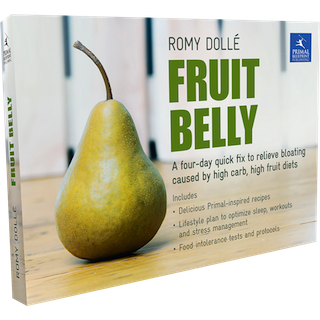 A little discussed phenomenon is disturbingly common among health-conscious eaters, especially those diligent about eating plenty of fresh vegetables and fruits, low-fat dairy products, and whole grains. Granted, not very primal, but even super-primal-aligned folks suffer from digestive difficulties related to eating their abundant servings of veggies and fruit. The condition is called Fruit Belly—a bloated cranky, gurgly, and visceral-fat-hoarding abdomen that grows (or refuses to budge) despite your best efforts to eat healthy, and even despite your success at sculpting the rest of your body.
A little discussed phenomenon is disturbingly common among health-conscious eaters, especially those diligent about eating plenty of fresh vegetables and fruits, low-fat dairy products, and whole grains. Granted, not very primal, but even super-primal-aligned folks suffer from digestive difficulties related to eating their abundant servings of veggies and fruit. The condition is called Fruit Belly—a bloated cranky, gurgly, and visceral-fat-hoarding abdomen that grows (or refuses to budge) despite your best efforts to eat healthy, and even despite your success at sculpting the rest of your body.
Romy Dollé is a Swiss author, chef, supermom and companion to sports trainer extraordinaire Dave Dollé. After suffering from the condition herself despite a super healthy, primal-aligned diet, she studied Fruit Belly extensively and prepared a fabulous resource to identify and help readers overcome this annoying and poorly-understood condition. Her comprehensive book, Früchte-Wampe, published in German, was a hit in Europe, so we have translated it and delivered it to the US market, with this post marking the official launch. Don’t miss the special offer I have for you below. But before we get that, a few more details about this fantastic new book.
A flat stomach isn’t just a matter of having low body fat; it also signals efficient digestion, optimal nutrition, and an eating regime that pleases our gut microbiome. And as many of us have experienced (but may be loath to admit), even a seemingly top-notch diet can lead to imperfect digestion and a poofy stomach that, while not an imminent danger, certainly is uncomfortable.
The reasons that healthy fruits and vegetables and other lauded nutritious foods can cause digestive problems might surprise you. First, while fruit is natural and primal and all that, we tend to overdo it these days, with year-round consumption of highly cultivated fruits that are larger and sweeter than the fibrous wild fruits our ancestors ate during narrow ripening seasons. Liberal fruit consumption can easily deliver an overdose of fructose (especially for those allowing fructose-laden fruit juices, processed beverages, and junk foods into the picture), which causes inflammation, bloating, and digestive distress.
Secondly, raw vegetables, while among the most nutritious foods on the planet, can ferment and produce gas during the digestive process. Romy actually recommends throwing cooked veggies into your smoothies to ease digestion. She also reminded listeners on her recent podcast (covering Fruit Belly topics, but extending into a wide range of fitness and health concepts, as she was joined by expert fitness trainer and world class sprinter Dave Dollé) that it’s important to chew our food slowly (or sip those smoothies slowly) to optimize the digestive process. Low-fat dairy products also get called out as contributing factors to digestive bloating. Of course, as we have discussed at length in the primal scene, the potential digestive problems from eating healthy plant foods are exacerbated by the consumption of pro-inflammatory gluten and other grains.
Read an excerpt of Fruit Belly
Download the PDF excerpt above here (large PDF).
So Romy is here to the rescue, offering a much-needed road map of the inner workings of your stomach and immediate relief in the form of a 4-Day Quick Fix to quickly eliminate the bloating and set the foundation for a long-term solution. Romy is the perfect guide for the journey. An entrepreneur, devoted mother, and MBA-wielding, Swiss-certified banker, Romy spent her youth in a small mountain village (where food was picked fresh, meals were left unadulterated, and digestion was superb). Her youth is starkly contrasted by her later city-dweller experiences working in a high-powered career (where her mood and physical wellbeing quickly took a nosedive). A labor of love, Fruit Belly is the culmination of Romy’s own research and experiences as she sought to restore her health and retrace the wisdom of her childhood roots.
Along with ushering you towards obvious physical improvements, the guidance in this book will help you repair your relationship with your midsection—which is more often the subject of our frustration than our appreciation (let’s face it, our stomachs put up with a lot from us). Fruit Belly shatters the myths surrounding seemingly healthy diet foods, explaining how they can actually lead to bloating and a less-than-shapely abdomen—hence the term “fruit belly.” You’ll find structured advice for what to eat and what to avoid, science-based explanations for how different foods affect the size and health of your midsection, and must-have insights about why a seemingly healthy diet still might not produce a flat stomach. And to top it off, Romy includes an assortment of tantalizing, primal-inspired, belly-friendly recipes to whet your appetite.
So, while Fruit Belly would make a fine gift for friends and family who aren’t fully on the primal bandwagon yet (especially those who, still under the spell of low-fat dietary guidance, can’t figure out why their Jamba Juice smoothies aren’t slimming them down), the seasoned primal eater has plenty to gain from this work as well. Fruit Belly provides a comprehensive and holistic game plan for your midsection, putting you on the path towards a happier belly—no matter where your dietary starting point is.
Here’s what you can expect from Fruit Belly:
Delicious, affordable recipes to ease digestive distress and boost fat loss
Menu guidelines for breakfast, lunch, and dinner
A lifestyle plan to optimize sleep, workouts, and stress management
A photo-illustrated roster of simple core-strengthening stretches and exercises (that you can do almost anywhere!)
The “Four-Day Quick Fix” to relieve bloating and achieve immediate improvement in your midsection
Food intolerance tests and protocols
Easy-to-understand explanations for how the human body digests and distributes nutrients in food
An exploration of the biochemical connection between mind and body that drives our sense of satiety
Inspiring testimonials
Per Mark’s Daily Apple tradition, I’ve put together an exciting limited-time offer for this book release. It expires on Tuesday, Oct. 6, 11:59 pm PST.
Limited-Time Offer
Order one or more copies of Fruit Belly from Amazon.com in any format (Kindle, audio, physical) by Oct. 6, and fill out this form to get all three of the following bonus items for free:
1. $10 Gift Certificate to PrimalBlueprint.com
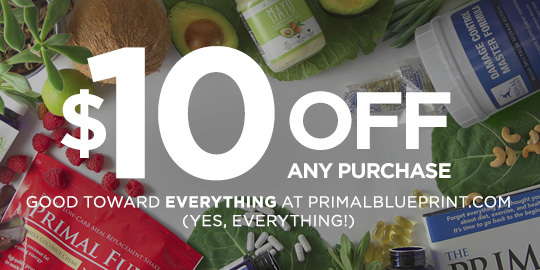
You can use this $10 gift certificate to purchase anything at PrimalBlueprint.com. Might I suggest Primal Probiotics—the ultimate probiotic blend that nourishes healthy intestinal bacteria and enhances digestion? This $10 gift certificate essentially covers the majority of the cost of the book!
2. Live webinar with Fruit Belly author Romy Dollé
 It’s one thing to read the book, but it’s another to get personal, real-time access to the expert herself! Want to go beyond the pages of Fruit Belly and receive a chance to have your personal diet and fitness questions answered by an authority? Purchase your copy of Fruit Belly by October 6th and gain exclusive access to a live online Q&A with Romy Dollé. She’ll go over the finer points of implementing her time-tested “no-bloat” protocol to help you optimize your health and shrink your waistline in the process.
It’s one thing to read the book, but it’s another to get personal, real-time access to the expert herself! Want to go beyond the pages of Fruit Belly and receive a chance to have your personal diet and fitness questions answered by an authority? Purchase your copy of Fruit Belly by October 6th and gain exclusive access to a live online Q&A with Romy Dollé. She’ll go over the finer points of implementing her time-tested “no-bloat” protocol to help you optimize your health and shrink your waistline in the process.
That’s right. If you purchase your copy of Fruit Belly by October 6th, you’ll get the opportunity to ask Romy your questions in real time from the comfort of your own home. Buy a book, get live access to a fitness expert.
How’s that for a bonus?
The event will be held via live streaming Saturday, October 10th at 12:00 pm PST. Grab your copy of Fruit Belly today to receive your link to the event!
3. 6 Foods You Should Be Eating for a Healthy Gut by Mark Sisson

6 Foods You Should Be Eating for a Healthy Gut is about—you guessed it—the specific foods to eat and avoid in order to obtain the healthiest gut possible. Gut health is paramount, as you well know. A healthy gut enables our digestion and immune response, our resistance to allergies and food sensitivities, and it even helps us maintain an even keel by regulating our mood. Without a healthy gut, we can’t truly be healthy, happy, productive or have the body we want. After reading this eBook, you’ll know exactly what to do to get one.
If Fruit Belly shows you how to banish your bloated stomach and remove unwanted belly fat, the 6 Foods eBook provides supplementary advice for folks who enjoy digging even deeper.
That’s it! Three great complementary bonus items, all for free when you grab a copy of Fruit Belly by Oct. 6. Just submit your purchase receipt using this form and we’ll email you all of the freebies in no time. Don’t miss out!
Fine Print:
This special bonus offer ends at 11:59 pm, Oct. 6, 2015 (PST).
All receipts must be received by 11:59 pm, Oct. 7, 2015 (PST). The forms will stop working on Oct. 8, so be sure to fill out the form and submit your pre-Oct. 7 receipt(s) by then.
On an iPhone? You won’t be able to upload your receipt from it, unfortunately. You’ll have to use a computer.
You will receive access to the webinar details, the eBook, and your PrimalBlueprint.com gift certificate via email within 24 hours.
Pre-orders will be honored for all bonus offers.
Both orders placed online (from any source) and in brick and mortar retail locations will be honored.
Both domestic (U.S.) and international orders are eligible for the bonuses.
All book formats are eligible, including physical books, audiobooks and digital versions (e.g. Kindle).
The PrimalBlueprint.com gift certificate expires on October 31, 2015, and is valid for a single use on orders valued at $10.01 or more.




September 28, 2015
Dear Mark: Lead in Crock Pots, Norovirus in Smoked Oysters, and Creatine and Carbs
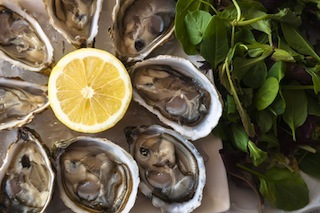 For today’s edition of Dear Mark, I’m answering three questions from readers. First, what’s the deal with lead in crock pots? Some say lead leaches into the food when we cook with crock pots, while others aren’t so sure. And if the leaching of lead from crock pot ceramics into our food is, indeed, a problem, what equivalent product do I recommend? Next, a new study indicates that human norovirus is highly prevalent in oysters. Should we stop eating the canned smoked oysters from Crown Prince? And finally, do we really need to consume extra carbs with our creatine to get the full benefits?
For today’s edition of Dear Mark, I’m answering three questions from readers. First, what’s the deal with lead in crock pots? Some say lead leaches into the food when we cook with crock pots, while others aren’t so sure. And if the leaching of lead from crock pot ceramics into our food is, indeed, a problem, what equivalent product do I recommend? Next, a new study indicates that human norovirus is highly prevalent in oysters. Should we stop eating the canned smoked oysters from Crown Prince? And finally, do we really need to consume extra carbs with our creatine to get the full benefits?
Let’s go:
Hi Mark,
Fall is here & I just got myself a new larger crockpot! I have been using it a TON (even though it’s not actually cold here in the south yet).
I was enjoying it immensely until I innocently Googled a question about my crockpot & found warning after warning about crockpots containing lead & leaching into our food, especially when we add acids like vinegar for bone broth or tomatoes in chili.
I checked crockpots out on MDA & found lots of recipes, but no warnings.
Should I be concerned about this? I have growing children. And I certainly don’t want to cause myself problems either.
I’d love for you to give us the lowdown.
Crockpots are my favorite kitchen tool! But, I have already made changes to the food we eat, I guess I can make changes to the way I prepare it too… if I HAVE to.
Thanks,
Beth
For millennia, lead has been used in ceramic glazes. And eating and cooking food using ceramic cookware glazed with lead can certainly cause lead poisoning. Consider the couple who got lead poisoning from brewing kombucha in a lead-glazed crock, or the person who did the same with kefir and got similarly poisoned. We know that . It’s a real possibility.
That said, crockpot manufacturers are aware of the problem and ceramic glazes these days are universally advertised as lead-free. Hamilton Beach claims its cookers contain no measurable amount of lead. One blogger went around asking the top crock pot companies about lead, receiving assurances from each company that either they had no lead in their glazes or crocks or that their lead levels were within FDA limits. But FDA limits technically allow some lead. And if you’re cooking meals for growing children with developing brains (whether they be in or out of the womb) for whom even tiny amounts of lead can hamper that development and cause epigenetic changes that reverberate through life, you’re right to be extra cautious.
Still, another blogger tested a few top brands (including a model from 20 years ago) with an XRF gun and found no evidence of lead in any of them. Personally? I have one. I don’t use it a whole lot anymore (you’ll learn why down below—it’s not due to lead), but I don’t really worry about the lead issue.
To be extra sure, buy a test kit online and run the tests yourself. In addition to doing a swab test of the ceramic surface and a leaching test using vinegar heated for four hours, I’d suggest preparing a typical meal in the pot, making sure to incorporate an acid (vinegar, tomato, red wine), and testing the food. To be extra, extra sure, take your crock pot and an acidic meal sample down to a third party tester. You should be able to find one on Google or Yelp (just search “lead test”).
Here’s what you do if you’re a real worrier and can’t get the notion that you’re poisoning your family out of your head:
Get an Instant Pot (or this earlier version which is just as good).
I’ve talked about these babies before. It’s an electric pressure cooker that plugs into the wall, sits on your counter, and renders the toughest slab of gristly animal into melt-in-your-mouth tenderness. Plus, Instant Pots can also make fantastic broth in a fraction of the time it takes on the stove, as well as act like crock pots, rice cookers, steamers, sauté pans, and other functionalities I’m probably forgetting right now. Best of all, the Instant Pot cooking pot is stainless steel. That means it’s easy to clean, non-reactive, and contains no lead at all.
You’ll be getting several-times the functionality of the crock pot without any of the worry—misplaced or not—over lead. Your kitchen game will increase exponentially.
I love the Crown Prince smoked oysters (Trader Joe’s) and with your blessing/recommendation, enjoy them often. However, just received this information/link. Now I am concerned. Can you comment. I value your opinion. Thank you.
Oysters harbor, transmit human norovirus: Avoid raw ones
“Oysters not only transmit human norovirus; they also serve as a major reservoir for these pathogens, according to research published August 28 in Applied and Environmental Microbiology, a journal of the American Society for Microbiology. ‘More than 80 percent of human norovirus genotypes were detected in oyster samples or oyster-related outbreaks,’ said corresponding author Yongjie Wang, PhD.”
Pat
Good news: your oysters are safe. Canned oysters are subjected to several rounds of heating.
First, they’re steamed in the shell at 105° C for 18 minutes.
Next, they’re either smoked for 10-20 minutes at 100-120 °C or, in newer facilities, for 20-30 minutes at 130-150 °C.
Then they’re added to cans along with oil (in this case olive oil) heated to 100 °C.
The cans are sealed and placed in a pressurized steam bath for 70 minutes at 120 °C.
Norovirus won’t survive all that heating.
The lead author of the study agrees, saying “eat them fully cooked, and never raw.” He’s totally cool with people eating oysters, as long as they’re cooked. Now, I’m not sure that’s necessary for everyone. I love slipping oysters down my throat. Raw, living oysters are one of the rare foods I can eat and intuitively know that I’m consuming something extremely nutritious. I almost get a burst of energy and good will from a half dozen of the raw, briny things. Besides, norovirus, while unpleasant, isn’t dangerous to anyone but the most immunocompromised, like the elderly and babies. The biggest danger from norovirus is the dehydration that can occur when you’re vomiting and spending your entire day on the toilet. But I don’t know too many infants getting pulverized raw oyster in their bottles, and I’d suggest that seniors derive more benefits from the bioavailable minerals oysters provide than they risk eating a few oysters.
Hi,
My name is Zach Resnick and I’m a big fan of the blog. I’m currently trying to stay in nutritional ketosis, but I’m also trying to build muscle mass. I’ve looked into creatine monohydrate as a supplement and have started taking it a few days back. However, after doing more reading on the subject the consensus seems to be that taking creatine with lots of carbohydrates is recommended for optimal absorption.
Given that I’m prioritizing staying in ketosis, do you know if it makes sense to take creatine just with my post workout meal as per normal? Is it ok to add a few extra carbs than normal to help with the creatine? I just fear much of the creatine I’m taking will be wasted and cause digestive issues if I don’t add some carbs back into my diet.
Thank you!
Zach
You’re good.
A 2005 study in experienced swimmers found that loading creatine was just as effective with carbs as without them. One group took 5 grams of creatine + 100 grams of carbs every day for five days. The other group just took creatine, no carbs. After a baseline performance test, they repeated the test after the loading phase. Both groups experienced similar benefits to swimming performance after taking creatine.
Another study found that taking either creatine alone or 250 calories-worth of carbohydrates alone produced equal improvements to repeated vertical leap performance over placebo control. The creatine supplementation caused a bit of weight gain (1.5 kg) from water retention.
But you’re also good if you take a few carbs with your creatine. If you want to do that and stay mostly ketogenic, you have a couple options: the cyclical ketogenic diet (CKD) or the targeted ketogenic diet (TKD).
On a CKD, you spend the majority of the week in ketosis, only eating carbs on one or two days. You might be ketogenic Monday through Friday, exercising all the while and capping the work week off with a really intense glycogen-depleting training session, then go high-carb, low-fat Saturday through Sunday to refill your depleted and newly-insulin sensitive muscle glycogen stores.
On a TKD, you stay ketogenic but selectively eat carbohydrate before, during, and/or after your workouts. Most people seem to benefit most from pre- and peri-workout carbs. These aren’t large carb loads—15-30 grams of relatively fast-absorbing, simple carbs. Baked potatoes, white rice, sweet potatoes are excellent options. Fruit works, too.
Whichever route you choose, just take the creatine around your workout. There may be some small advantage to taking the creatine post-workout.
Creatine shouldn’t upset your stomach or affect your digestion, but it might increase your water requirements. Just be aware of them and drink water when thirsty, as always. Consider sprinkling in a little sea salt, too.
That’s it for today, everyone. Thanks for reading and be sure to chime in with your comments and input down below!




September 27, 2015
Weekend Link Love – Edition 367

I want to give a HUGE thank you to everyone who submitted an essay for the Primal Blueprint Scholarship. Between my staff and I, we read every single submission (and there were LOTS of submissions). The sincerity, passion, and strength in each and every essay makes me proud to be part of this community, and thankful to those that read what I write here at Mark’s Daily Apple. And, of course, I’d like to give a big congratulations to our three scholarship winners: Lana, Buck and Tanja. We’re all thrilled to have you on board the growing community of Primal Blueprint Certified Experts! Thanks again, everyone. I hope to see many of you in the program soon. Grok on!
Research of the Week
Drinking ketones sustained athletic performance while reducing muscle glycogen utilization.
A Lactobacillus rhamnosus probiotic supplement helped allergic infants overcome dairy protein allergy by shifting the composition of their biomes and increasing butyrate production.
If you’re going to sit, fidget. It could counteract some of the damage.
Rosacea might be an adaptive response to low UV environments.
New Primal Blueprint Podcasts

Episode 86: Bill Grundler: Host Brad Kearns joins Bill Grundler, a CrossFit legend, retired firefighter, and owner of CrossFit Inferno out of San Luis Obispo, for a chat about competition, injuries (and how they can be a blessing in disguise), being a Masters CrossFit athlete and competitor, his experience taking the PB Expert Cert, and what may be in store for the future of CrossFit.
Each week, select Mark’s Daily Apple blog posts are prepared as Primal Blueprint Podcasts. Need to catch up on reading, but don’t have the time? Prefer to listen to articles while on the go? Check out the new blog post podcasts below, and subscribe to the Primal Blueprint Podcast here so you never miss an episode.
10 Things You Shouldn’t Do If You’re Trying to Build Muscle
What You Need to Know About Foodborne Illness — Part 2: Kitchen Strategies
Also, be sure to check out and subscribe to the Primal Endurance Podcast.
Weekly sweepstakes: Write a review for The Primal Blueprint Podcast or The Primal Endurance Podcast on iTunes and submit this form for a chance to win a Primal prize package. One new winner is chosen every week!
Interesting Blog Posts
Sitting: it’s bad for kids, too.
Speaking of which, could standing desks solve the childhood obesity epidemic?
A thorough rebuttal of some of the points made and references used in the “paleo starch” paper from last month.
How dairy and coconut fat protect against type 2 diabetes.
Media, Schmedia
Thanks to Craig Venter’s new company, whole exome tests may soon be available for just $250.
Of the autopsies performed on 91 former NFL players, 87 revealed chronic brain disease.
Everything Else
Every person emits a unique bacterial aura.
Scientists have discovered the earliest evidence of ambush hunting by humans in the Kenyan Rift.
Look at this cocky motor protein strut along cytoskeletal filament.
If you’ve got one, you can use your 3-D printer to make your own replicas of the new Homo naledi fossils. The data is free to access.
Neanderthals were avid bird-catchers. Why?
Early Americans were eating salmon at least 11,500 years ago. Better have been wild!
Recipe Corner
Better, healthier tater tots.
Simple, fast, delicious egg drop soup.
Time Capsule
One year ago (Sep 29 – Oct 5)
How to Deal With Health “Noise” – Focus only on the important stuff.
16 Ways Green Space Improves Your Life – Trees aren’t just nice to look at.
Comment of the Week
Is butter a bribe?

– Great show.




September 26, 2015
Lamb Chili with Harissa
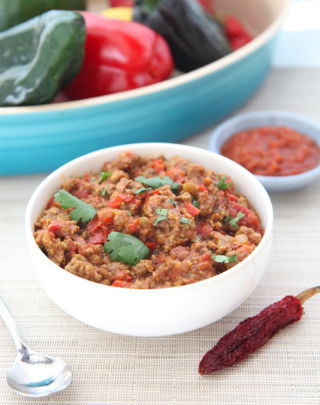 Your next pot of chili doesn’t have to be the same old ground beef chili.
Your next pot of chili doesn’t have to be the same old ground beef chili.
Instead, cook up a pot of ground lamb seasoned with things like turmeric and ginger and a few tablespoons of fiery harissa. The end result is a meal that’s still recognizable as chili but has delicious new flavor.
You know the drill with lamb by now: it’s a nutritionally complete protein packed with all 8 essential amino acids and a whole lot of vitamins and minerals. Lamb can be challenging to cook, but when your butcher grinds it for you and it’s used as the base for chili, there aren’t any worries about overcooking the meat and making it tough. This is an easy and stress-free way to cook lamb.
Harissa is used as the main spice component in this lamb chili. This Middle Eastern condiment gives chili (even beef chili) amazing flavor and adjustable heat. Two tablespoons of harissa adds a slow, robust burn to a pot of chili. Cut back to 1 tablespoon for less heat, or, use the harissa strictly as a condiment. That way, everyone can give their own bowl of chili as much or as little heat as they want.

Servings: 4
Time in the Kitchen: 1.5 hours
Ingredients:
1 ½ pounds ground lamb (680 g)
1 tablespoon extra virgin olive oil (15 ml)
1 white or yellow onion, finely chopped
2 garlic cloves, chopped
2 red bell peppers, finely chopped
1 teaspoon cumin (5 ml)
½ teaspoon turmeric (2.5 ml)
¼ teaspoon ground ginger (a pinch)
¼ teaspoon cinnamon (a pinch)
1 teaspoon kosher salt, plus more to taste (5 ml)
1 14.5 ounce can diced tomato (425 g)
1 cup water (240 ml)
2 tablespoons harissa, or more or less to taste (15 ml)
Chopped cilantro, for garnish
Instructions:
Warm the olive oil over medium-high heat then add the onion, garlic and red pepper. Saute until onion is soft, about 5 minutes.
Add cumin, turmeric, ground ginger and cinnamon. Cook 1 minute, stirring the spices into the onions. Add ground meat and season with salt.
Break up the ground meat as it cooks. When it is almost cooked through and barely pink, add the can of diced tomato, water and harissa.
Simmer gently, with a lid just barely cracked, for 1 hour. Stir occasionally.
Top with cilantro and serve, with harissa on the side.
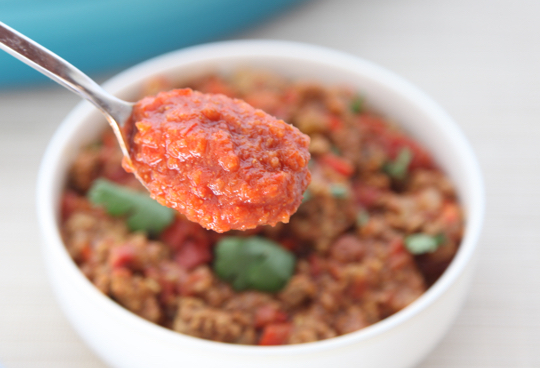
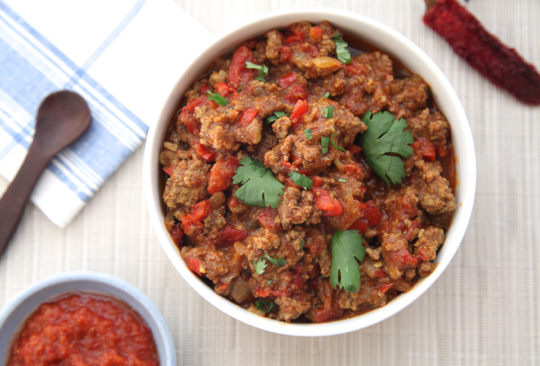
Not Sure What to Eat? Get the Primal Blueprint Meal Plan for Shopping Lists and Recipes Delivered Directly to Your Inbox Each Week. Now Available as an App!






September 25, 2015
The Primal Lifestyle Works for Me
It’s Friday, everyone! And that means another Primal Blueprint Real Life Story from a Mark’s Daily Apple reader. If you have your own success story and would like to share it with me and the Mark’s Daily Apple community please contact me here. I’ll continue to publish these each Friday as long as they keep coming in. Thank you for reading!
 Several years ago I went from my 15 year career working in hospitality management and found a government job in a call centre. It was at this time I fell in love with my future wife who also worked in the call centre. I weighed in at about 96 kg at this stage and thought I was relatively fit. Though the only sport I was involved in was basketball with my mates, maybe once a fortnight.
Several years ago I went from my 15 year career working in hospitality management and found a government job in a call centre. It was at this time I fell in love with my future wife who also worked in the call centre. I weighed in at about 96 kg at this stage and thought I was relatively fit. Though the only sport I was involved in was basketball with my mates, maybe once a fortnight.
I had never been more sedentary than when I was working in the call centre, and after having proposed to my wife six months after we met, I guess I kind of stopped putting in any effort with my appearance. My skin was blotchy and the kilograms started to pile on. I married my wife two years after we met, weighing in at 108 kg.
 A couple of years later, my blood pressure was high (due to a bad diet, not being married), and my motivation and energy levels were low. My diet was terrible with fast food (an easy option), sandwiches were a regular occurrence, and I used to drink juice and soft drinks. It wasn’t until my wife got pregnant with our first child that I decided I needed to do something about my weight and lifestyle. I didn’t want to be an overweight, unhappy father. I wanted to be a fit and healthy dad with loads of energy that my kids would be proud of.
A couple of years later, my blood pressure was high (due to a bad diet, not being married), and my motivation and energy levels were low. My diet was terrible with fast food (an easy option), sandwiches were a regular occurrence, and I used to drink juice and soft drinks. It wasn’t until my wife got pregnant with our first child that I decided I needed to do something about my weight and lifestyle. I didn’t want to be an overweight, unhappy father. I wanted to be a fit and healthy dad with loads of energy that my kids would be proud of.
I tried all sorts of diets/fads and switched to multi-grain bread, skim milk, and diet soft drinks. I started walking, then running, and lost a little bit of weight (100 kg). My skin was still blotchy and still had some weight to lose. I got to the stage where I was running 5 km a day and went on to complete triathlons and a half marathon. I was able to lose several more kilos doing this amount of cardio and eating what dietitians would call a “healthy diet”.
In the midst of this I got really sick with the flu, but I continued to run, eat grains and sugar. I needed to do something to help regain my health. After doing a lot of research and trying shake diets, soup diets, detoxes, protein diets, etc., I came across paleo and it made sense to me. Simple as that. I started to feel less bloated and had more energy. Though I was still doing a lot of cardio, my niggling injuries and cough remained the same.
After a couple of months of eating 80/20 paleo, I stumbled across The Primal Blueprint and Mark’s Daily Apple. This made more sense and what I really found to be valuable was the fact it encompasses a lifestyle rather than just a diet. After reading The Primal Blueprint and scouring the pages on MDA, I increased my healthy fats, proteins and leafy greens to basically cover everything I ate. Instead of eating fruit for snacks, I substituted a handful of nuts, boiled eggs or avocado with salmon or chicken. The only fats I cook with now are organic butter or organic coconut oil. The only meats I eat are either organic or grass-fed, which again makes a lot of sense to eat from an animal that has not been force fed something that can make it ill.
We have grown our own vegetable patch where my two girls and I love going out and eating the cherry tomatoes straight from the vine. I love making my own bone broth from organic bones to use as a snack, incorporate it into my girls meals (when I can), and make a killer ramen with kelp noodles for my wife and I. I have incorporated intermittent fasting which I thought would be difficult, but now I really enjoy the clarity and feeling I acquire after fasting for 18+ hours.
I re-evaluated my whole exercise program and now sprint once or twice a week, depending on if and when I feel like it (which surprisingly enough happens more than one might think). We live across the road from a national park and I go for many bushwalks (sometimes four per week for about 8-10 km) and really enjoy the peace and quiet of nature, the fresh air and the relatively easy pace at which you walk in the bush. I don’t feel like I am exercising at all! I often go mountain biking in the forest, and I lift heavy weights a couple of times a week.
I still work in the government call centre, but I use a stand-up work station and often go for a 3 km walk on my lunch/dinner breaks to get some fresh air. I am now maintaining my weight (90 kg) fairly easily.
Occasionally I seem to lose track of the primal way but all I need to do now is to take a moment and evaluate how I am feeling, my energy levels and my overall mojo and state of mind. These “off track moments” are brief and are occurring less and less. Something that works for me to help me get back on track is to go for a bushwalk or do a fast. I call this my “F5 button” or “refresh/reset”.
My skin has cleared up, I no longer need to find energy to play with my two beautiful girls and incorporate a lot of playing into our lives. I am teaching them how to throw a frisbee, but this has taken a bit longer than I thought it would. All I usually hear from them is, “Daddy! Kids are not targets!!”
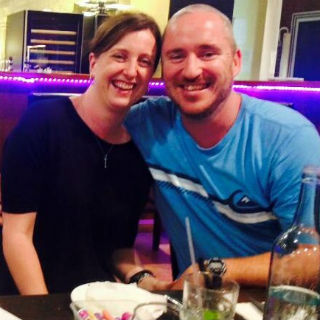 The Primal lifestyle works for me. I talk to people about what I have done, as I get a lot of comments on how I have changed. I am proud to promote The Primal Blueprint and Mark’s Daily Apple to anyone and everyone. Next year I turn 40 and I really believe that I will be in the best shape of my life because of The Primal Blueprint.
The Primal lifestyle works for me. I talk to people about what I have done, as I get a lot of comments on how I have changed. I am proud to promote The Primal Blueprint and Mark’s Daily Apple to anyone and everyone. Next year I turn 40 and I really believe that I will be in the best shape of my life because of The Primal Blueprint.
I am currently studying to be a personal trainer and have registered the business name “Primal Sweat”. I am looking at doing the Primal Blueprint Expert Certification over the next year or so, then I can help others feel better, look better and be better. I have read The Primal Blueprint a couple of times now and I am sure I will again in the future.
Thanks, Mark, you have changed my life and my family’s lives!!
Lachlan




September 24, 2015
This $1000 Primal Shopping Spree Could Be Yours
 Today’s the day for another primal giveaway! Over the last year I’ve teamed up with Thrive Market to give Mark’s Daily Apple readers (you!) free jars of coconut oil, free jars of Primal Kitchen™ Mayo, exclusive eBooks, and even a $500 primal shopping spree. Not to mention dozens of free memberships. But now we’re taking things to the next level. Today, Thrive Market is offering Mark’s Daily Apple readers a chance to win a $1000 shopping spree.
Today’s the day for another primal giveaway! Over the last year I’ve teamed up with Thrive Market to give Mark’s Daily Apple readers (you!) free jars of coconut oil, free jars of Primal Kitchen™ Mayo, exclusive eBooks, and even a $500 primal shopping spree. Not to mention dozens of free memberships. But now we’re taking things to the next level. Today, Thrive Market is offering Mark’s Daily Apple readers a chance to win a $1000 shopping spree.
As you know, I’m a big fan of Thrive myself—to the point where I became an investor. I believe in their social mission, and I’ve been reaping savings from the deep discounts they offer on wholesome paleo/primal foods. The discounts come from the power of a membership community—just like Costco, Netflix and NPR. For less than $5 a month ($59.95 annually), members get products at wholesale prices, without store overheads to drive up costs. That membership fee also sponsors a free membership for a family in need. Plus, they ship your order directly to your front door, and shipping is free on orders over $49.
If that still seems like a big commitment to make right away, don’t worry—every new Thrive Market member gets a free 1-month trial membership before becoming a paying member, and this latest sweepstakes is also giving away 10 free 1-year memberships.
Ready to stock up on everything from healthy snacks to green home products? One grand-prize winner will walk away with a free 1-year membership and $1,000 to spend at Thrive Market. That’s about 10 years worth of Primal Kitchen™ Mayo. And that’s not all—10 other runners up will win a free 1-year membership, too! Click here to qualify for the trial membership and enter the shopping spree sweepstakes. Anyone can enter—even existing Thrive Market members—but only first time members get 25% off their first purchase. There’s no purchase necessary. This sweepstakes expires on October 7th.
By voting with our dollars and purchasing products from ethical companies offered on Thrive Market, we are participating in a larger virtuous cycle that is good for our bank accounts, good for our families, good for the economy, and good for the environment. I hope you will join the Thrive Market movement today.




Mark Sisson's Blog
- Mark Sisson's profile
- 199 followers



